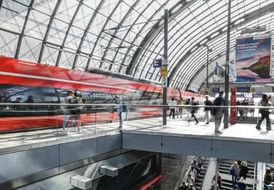Recycling rate
We will continue to maintain our recycling rate at its high level of at least 95%. Especially in the construction and maintenance of our track infrastructure and our vehicle fleet, we produce waste that contains valuable resources such as metals and mineral building materials. The majority of these resources are already recycled.
Volume of waste according to type of waste and disposal procedure / thousand t | 2022 | 2021 | 2020 |
Construction waste | 7,657 | 8,342 | 7,656 |
Recycling | 7,449 | 8,069 | ‒ |
Thermal utilization and disposal | 208 | 273 | ‒ |
Scrap | 363 | 327 | 331 |
Recycling | 362 | 327 | ‒ |
Thermal utilization and disposal | 0.2 | 0.1 | ‒ |
Electronic scrap | 1.3 | 3.8 | 1.8 |
Recycling | 0.9 | 3.3 | ‒ |
Thermal utilization and disposal | 0.4 | 0.5 | ‒ |
Municipal waste | 71.1 | 55.3 | 53.6 |
Recycling | 37.8 | 23.7 | ‒ |
Thermal utilization and disposal | 33.3 | 31.6 | ‒ |
Paper | 32.6 | 37.9 | 31.4 |
Recycling | 31.0 | 37.2 | ‒ |
Thermal utilization and disposal | 1.6 | 0.7 | ‒ |
Waste oil | 2.0 | 1.7 | 1.8 |
Recycling | 1.8 | 1.4 | ‒ |
Thermal utilization and disposal | 0.1 | 0.2 | ‒ |
Other 1) | 61.0 | 61.7 | 58.1 |
Recycling | 32.8 | 32.5 | ‒ |
Thermal utilization and disposal | 28.2 | 29.2 | ‒ |
Total waste | 8,187 | 8,830 | 8,134 |
Recycling | 7,916 | 8,495 | 7,771 |
Thermal utilization and disposal | 272 | 335 | ‒ |
Recorded for the first time in 2021 according to the new GRI Standard 306: Waste, thus only limited previous year’s figures available.
Period from October 1 to September 30; DB Schenker January 1 to December 31 of the previous year.
Individual values do not add up due to rounding differences.
Excluding DB Arriva. DB Cargo AG is the only part of the DB Cargo business unit included.
The waste has been generated through company activities and is managed by third parties outside DB Group.
1) For example paint, varnish, sludge and other maintenance-related waste.
- In 2022, a total of around 0.6 million t less waste was generated. The main driver was the construction waste, which decreased by about 8%. The recycling rate was 96.7%. By using targeted measures, such as selective decommissioning and contractual commitments to sorting and recycling facilities, we kept the share of recyclable waste high and the share of waste destined for disposal or incineration at a very low level.
- We generally carry out the thermal waste treatment of waste to be burnt. The energy released during burning is used there and released as electrical energy, heat and/or process steam.
- Municipal waste only accounts for a small share of our total waste generation, but it is the most visible fraction in our trains and stations. The strategy for disposing of mixed municipal waste, which aims to recycle as much of the recyclable material contained therein as possible, has proven a success. Thanks to state-of-the-art sorting methods, at least 85% of recyclable material contained can be clearly separated for recycling. The amount of recycled municipal waste increased noticeably by around 70%.
Volume of hazardous and non-hazardous waste / thousand t | 2022 | 2021 |
Hazardous waste | 385 | 477 |
Share of recycling (%) | 62.0 | 67.9 |
Share of thermal utilization and disposal (%) | 38.0 | 32.1 |
Non-hazardous waste | 7,802 | 8,352 |
Share of recycling (%) | 98.4 | 97.8 |
Share of thermal utilization and disposal (%) | 1.6 | 2.2 |
Total waste | 8,187 | 8,830 |
Period from October 1 to September 30; DB Schenker January 1 to December 31 of the previous year.
Individual values may not add up due to rounding differences.
Excluding DB Arriva. DB Cargo AG is the only part of the DB Cargo business unit included.
Of the waste generated in 2022, about 95% (previous year: 95%) was classified as non-hazardous. This includes, for example, municipal waste and the majority of construction waste. The remainder, about 5%, includes waste that presents a risk to health or the environment – for example waste oil or contaminated waste wood. Special procedures ensure that this waste is disposed of safely. Here, too, we consider the conservation of resources and look at opportunities for recycling or thermal utilization of waste.


